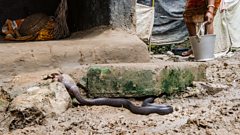Human
Discover the extraordinary ways in which wildlife survives in a rapidly changing human world. From cobras hunting in houses to macaques stealing mobile phones to barter with.
The human world, from our cities to our fields, has spread to every corner of the globe. Wildlife must now adapt to a vastly altered landscape… and contend directly with us.
Some animals are meeting this challenge head-on and thriving. In Bali, long-tailed macaques have learned to steal tourists’ most precious items and then use them to barter with temple staff for their favourite food. The older males simply won’t give you back your phone unless they get what they’re after.
For many animals living alongside us, it pays to keep a low profile. Tawny frogmouths are masters of camouflage, and in Melbourne, Australia, they are preyed upon by pet cats. Nevertheless, frogmouths are doing well here because the streetlights help them find their prey, and in many parts of the city they are now found in a higher density than in the surrounding countryside.
Some animals are so bold, they don’t even try to hide. Rhinos walk through the streets of Sauraha, Nepal, simply to reach food on the other side of town. In Lake Tahoe, USA, black bears head right to the centre of town in search of food. Ahead of hibernation, it is crucial to put on as much weight as possible. The rich food these city bears can find in the dumpsters means that they are up to 50 per cent heavier than their country cousins. Some enterprising individuals have gone a step further. They have worked out that a simple push on a door can lead them into a room stacked high with food. Quite a surprise for someone popping into the shop to buy a snack.
For wildlife, part of the challenge is to keep up with us. Pavement ants are the most common ant in New York City, outnumbering New Yorkers by 1,000 to 1. The secret to their success is their digestive system, which has been able to keep pace with the constantly changing human diet. Ninety per cent of what they eat now comes from human food. On Broadway Avenue alone, they eat the equivalent of 60,000 hotdogs a year.
Life is not so straightforward for animals that are feared or persecuted by humans. Snakebites cause an estimated 60,000 human deaths every year in India alone, but in one Indian village, venomous cobras are seen hunting inside peoples’ houses. Remarkably, scientists believe that this co-existence has led to a change in the snakes’ behaviour. They move more slowly and are less likely to strike when disturbed.
However, when animals come into the human world to compete for resources, it often leads to conflict. In Kenya, once the sun has set, African elephant bulls venture to fields of tomatoes to gorge. It’s a dangerous job for the farmers trying to repel the largest land animals on the planet.
Wildlife that eat the same food as humans doesn’t always result in competition. Humpback whales off the coast of Vancouver Island inhabit waters that have been overfished. You would think that their presence would reduce fish stocks even further, but astonishingly the opposite is thought to be happening. It is all because of the iron in the whales’ poo! It fertilises the ocean here and feeds the phytoplankton, which is the basis of the food chain. The fish feed on the growing phytoplankton population and, even though the whales are feasting on them, their numbers are predicted to increase.
Not only do the whales, and their poo, play an important role in restoring the ecosystem, but they also combat climate change. The phytoplankton photosynthesise, taking carbon out of the atmosphere, just like trees do. Thanks to whale poo, their numbers grow to such an extent that each great whale has the same impact as planting 30,000 trees!
Although some species are managing to thrive in the human world, in many parts our actions are putting unprecedented pressure on wildlife. Our fates, however, are closely intertwined. If the natural world is not protected, it could be devastating for all of us. The major challenge will be reimagining the way we live on this planet to find ways to protect all life on earth.
Last on
More episodes
Previous
Next
![]()
In pictures: Human
Get a taste of what's featured in the Human episode of Planet Earth III
![]()
How much can you remember about the Human episode?
Test yourself with the C����ý quiz
Clips
-
![]()
Rhino in the city
Duration: 01:35
-
![]()
Sir David Attenborough suggests a way of making space for nature
Duration: 02:09
-
![]()
A highly venomous cobra hunts a toad through a village in India
Duration: 03:13
-
![]()
Web exclusive: Making a living in the Amazon
Duration: 02:55
Credits
| Role | Contributor |
|---|---|
| Presenter | David Attenborough |
| Production Manager | Bronwen Thomas |
| Executive Producer | Michael Gunton |
| Series Producer | Matt Brandon |
| Series Producer | Jonny Keeling |
| Producer | Fredi Devas |
Explore different habitats and make origami animals, or download the poster 'Our Changing World' from The Open University
Visit The Open University website to learn about fascinating animals in their habitats.







